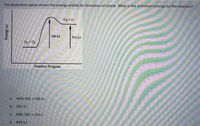
Chemistry
10th Edition
ISBN: 9781305957404
Author: Steven S. Zumdahl, Susan A. Zumdahl, Donald J. DeCoste
Publisher: Cengage Learning
expand_more
expand_more
format_list_bulleted
Question
thumb_up100%

Transcribed Image Text:The illustration below shows the energy profile for formation of ozone. What is the activation energy for the reaction?
O3 +0
406 kJ
392 kJ
O2 + O2
Reaction Progress
a. 406+392 =798 kJ
b. 392 kJ
O c. 406-392 = 14 kJ
d. 406 kJ
Energy, kJ
Expert Solution
This question has been solved!
Explore an expertly crafted, step-by-step solution for a thorough understanding of key concepts.
This is a popular solution
Trending nowThis is a popular solution!
Step by stepSolved in 2 steps

Knowledge Booster
Learn more about
Need a deep-dive on the concept behind this application? Look no further. Learn more about this topic, chemistry and related others by exploring similar questions and additional content below.Similar questions
- 11. A reaction has a rate constant of k = 3.40 L2 mol-2 min -1, What is the overall reaction order? 1. 1 st order 2. 2nd order 3. 3rd order 4. 4th order 5. none of the abovearrow_forwardLabel the reaction profiles below as exothermic or endothermic and use them to calculate the activation energy of the forward and reverse reactions and the value of AH for the reaction. This is a reaction of profile of an 250 exothermic/endothermic reaction 200 PE 150 (kJ) Eaf = ...... 100 Ea, = 50 AH = Reaction pathway 100 This is a reaction of profile of an 80 exothermic/endothermic reaction 60 PE (kJ) A+B 40 Ear = C+D 20 Ear = ΔΗ Progress of the reactionarrow_forwardIf the order of the reaction is first order for both reagents then using the rate law and the following data solve for K. Rate 1.9 X 10^-6 [I-] = 0.45 M [H2O2] = 0.125 M O A. 1.1 X 10^-5 O B.3.4 X 10^-5 O C. 3.4 X 10^-4 O D. 1.1 X 10^-7arrow_forward
- r = L [A] [B] ² x2 x 2 r=k [2A) [21] ² 8x bigger than 2 + 4 = 8 12. Consider a reaction of the form 2A + BC. The data for this reaction is given below: Initial rate of formation of C M/s Initial [A] Initial [B] 4.0 x 10-² 0.30 0.10 2.0 x 10-² 0.50 0.05 6.0 x 10-² 0.50 0.15 1.0 x 10-² 0.025 a. What rate law is consistent with this data? 0.40 b. Calculate k and specify units. How long will it take for the concentration of C to equal to 0.10 molar if the initial concentration of all the species are [A] = 0.4 M, [B] = 0.3 M and [C] = 0.0 M?arrow_forward2. What is the unit of k for each of the following type of reaction? First order reaction a. b. Second order reaction Third order reaction c.arrow_forwardAnswer the following question using the reaction coordináte diagram shown below. 280 240 200 160 120- 80 40 Time What is the activation energy for the reverse reaction? O A. -160 kJ B. -80 kJ O C. 80 kJ D. 160 kJ tent (H) kilojoulesarrow_forward
- 45arrow_forwardThe proposed mechanism for a reaction is NO + 03 2 N03 0 Fast pre-equilibrium NO3+0 N02 +02 Slow Which of the following would be a rate law for the reaction? OA. rate k[NO][03] B. rate k[O3] OC. rate = k[NO] O D. rate = k[O][NO3] E. rate k[NO2][02]arrow_forwardWhat is the value of the Arrhenius activation energy (E) for a chemical reaction if the rate constant, k, is 2.0 x 1045at 310 K and 6.0 x 10 s at 320 K ? (Gas constant R = 8.314 J/mol. K) Select one: O a. 24 kl/mol O b. 91 kl/mol O c. 42 kJ/mol O d. 72 kJ/molarrow_forward
- The activation energy for the reaction of 2 NO2(3) 2NO(g) + O2(g) has been determined to be 111 kJ-mol-1. If the rate constant at 300 °C is 0.54 M-1.s-1, what is the rate constant when the temperature is increased to 310 °C? 0.00050 M-1.s-1 0.54 M-1.s-1 0.81 M-1.s-1 2.3 M-1.s-1arrow_forwardGiven the intermediate step for the reaction: SO + O2 > SO2 + O Which collision path would be an "effective" collision? A. SO- O=O or B. O=O- SO Then explain why you selected the choice.arrow_forward
arrow_back_ios
arrow_forward_ios
Recommended textbooks for you
 ChemistryChemistryISBN:9781305957404Author:Steven S. Zumdahl, Susan A. Zumdahl, Donald J. DeCostePublisher:Cengage Learning
ChemistryChemistryISBN:9781305957404Author:Steven S. Zumdahl, Susan A. Zumdahl, Donald J. DeCostePublisher:Cengage Learning ChemistryChemistryISBN:9781259911156Author:Raymond Chang Dr., Jason Overby ProfessorPublisher:McGraw-Hill Education
ChemistryChemistryISBN:9781259911156Author:Raymond Chang Dr., Jason Overby ProfessorPublisher:McGraw-Hill Education Principles of Instrumental AnalysisChemistryISBN:9781305577213Author:Douglas A. Skoog, F. James Holler, Stanley R. CrouchPublisher:Cengage Learning
Principles of Instrumental AnalysisChemistryISBN:9781305577213Author:Douglas A. Skoog, F. James Holler, Stanley R. CrouchPublisher:Cengage Learning Organic ChemistryChemistryISBN:9780078021558Author:Janice Gorzynski Smith Dr.Publisher:McGraw-Hill Education
Organic ChemistryChemistryISBN:9780078021558Author:Janice Gorzynski Smith Dr.Publisher:McGraw-Hill Education Chemistry: Principles and ReactionsChemistryISBN:9781305079373Author:William L. Masterton, Cecile N. HurleyPublisher:Cengage Learning
Chemistry: Principles and ReactionsChemistryISBN:9781305079373Author:William L. Masterton, Cecile N. HurleyPublisher:Cengage Learning Elementary Principles of Chemical Processes, Bind...ChemistryISBN:9781118431221Author:Richard M. Felder, Ronald W. Rousseau, Lisa G. BullardPublisher:WILEY
Elementary Principles of Chemical Processes, Bind...ChemistryISBN:9781118431221Author:Richard M. Felder, Ronald W. Rousseau, Lisa G. BullardPublisher:WILEY

Chemistry
Chemistry
ISBN:9781305957404
Author:Steven S. Zumdahl, Susan A. Zumdahl, Donald J. DeCoste
Publisher:Cengage Learning

Chemistry
Chemistry
ISBN:9781259911156
Author:Raymond Chang Dr., Jason Overby Professor
Publisher:McGraw-Hill Education

Principles of Instrumental Analysis
Chemistry
ISBN:9781305577213
Author:Douglas A. Skoog, F. James Holler, Stanley R. Crouch
Publisher:Cengage Learning

Organic Chemistry
Chemistry
ISBN:9780078021558
Author:Janice Gorzynski Smith Dr.
Publisher:McGraw-Hill Education

Chemistry: Principles and Reactions
Chemistry
ISBN:9781305079373
Author:William L. Masterton, Cecile N. Hurley
Publisher:Cengage Learning

Elementary Principles of Chemical Processes, Bind...
Chemistry
ISBN:9781118431221
Author:Richard M. Felder, Ronald W. Rousseau, Lisa G. Bullard
Publisher:WILEY